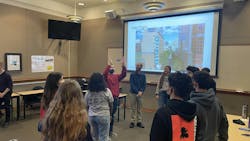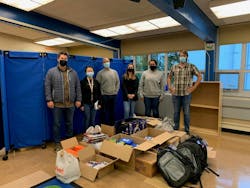K-12 school construction: 5 ways strong community relations can lead to success
Skanska is a leader in K-12 school projects throughout the Pacific Northwest. We build schools that create supportive learning environments, and campuses that serve students and the local community for generations to come. Our success on these projects largely relies on developing a good relationship with local stakeholders to ensure the safety of all students, while delivering projects on time and on budget.
When constructing a K-12 school, building positive relationships with the community—including students, parents, school staff and residents—is critical to the success of the project. Here are five ways Skanska puts the community first when building K-12 schools in the Pacific Northwest.
1. Listen and act on community concerns
Every community we work in is unique. It’s important to understand a community’s needs and how we can mitigate concerns throughout the construction process.
In action:
The parent drop-off and pickup spot is a busy area that requires extensive coordination. On our Edwards Elementary project in Newberg, Oregon, this area was located off a busy street, and was also where our main construction entrance was located.
We intentionally re-routed to the west side of the site—which isn’t the most efficient for us to get deliveries in and out—because it’s safer for the community.
This project also featured a modular trailer that housed two classrooms during construction. Parents were concerned about the trailer’s location because strangers could potentially approach students as they walked out of the existing building to the modular trailer.
So, our team added a fence system with gates and locks around the trailer to put parents’ minds at ease, while reinforcing our client’s trust to ensure students’ safety.
2. Build connections with students and teachers
Making connections with students and teachers is instrumental in the successful construction of a school.
In action:
On multiple school projects, we’ve held hard hat sticker contests for students. Students participated in a drawing contest and the winning student’s submission became a hardhat sticker our team members wore on their hardhats.
During the pursuit of our Bryant Montessori K-8 project in Tacoma, Washington, each of our mechanical, electrical, and civil subcontractors committed to a series of community and student engagement goals.
Each subcontractor also committed to donating 0.1% of their project fee to create a scholarship that was awarded to a Bryant Montessori student entering college.
On our Mountain View High School project in Vancouver, Wash., our team donated ply sheets for students to paint on. Students created twenty murals that were hung up on the jobsite throughout construction.
3. Educate and inspire
Outside of our daily job responsibilities, our team members jump on opportunities to educate and inspire students at the schools they construct.
In action:
On our Center for Deaf and Hard of Hearing Youth project in Vancouver, Wash., our team took drones to campus so middle and high school students could learn how technology supports a project’s overall design and execution. Currently, drones are being used for the school’s expansion to scan and photograph the construction progress.
4. Get involved with school events
When working on a school project, our teams explore ways to get involved in local school events. It goes a long way in forming a successful relationship with community members.
In action:
Every fall, Edwards Elementary hosts an annual jog-a-thon, for which students ask family and friends to donate money for every lap they walk or run. The event promotes physical activity and raises funds for the school to host additional programming. Our team members provided power and resources for the event, wore school t-shirts, and cheered on the students in support of the school and community.
Our team also participated in an assembly and meetings with teachers and parents. To show their appreciation during the holidays, teachers and students created thank you cards for our construction team and the school crossing guard knitted our team tiny safety cones.
5. Give back to the local community
When we approach a K-12 project, we determine the school’s needs and how we can give back to the community in the most impactful way.
In action:
On our Browns Point Elementary School project in Tacoma, Washington, a third-grade student named Jacob used to walk past our job site on the way to school each day with a sign that read “Thank You.”
Jacob appreciated our team’s efforts in building the new school he would attend. To show our appreciation for Jacob, our team invited him to be superintendent for the day one summer. Jacob was outfitted with all the necessary Personal Protective Equipment (PPE) and helped install some work and direct the weekly subcontractor meeting.
Our team has worked extensively in Tacoma, so giving back to the local community is a priority. Winters are frigid in the area so our subcontractors raised about $15,000 to buy 500 coats they donated to elementary schools in the area, to support students with the greatest needs.
During the holidays, our team members also host backpack drives for the communities where we work.
Leaving a lasting impact on the communities where we build
Construction companies have a responsibility to do right by the communities in which they build. On school projects, this includes developing a strong relationship with school administrators and instructors, students, parents, neighbors and other stakeholders who are impacted by the construction of a school. We look forward to continuing to support education systems that foster our future leaders and changemakers.



